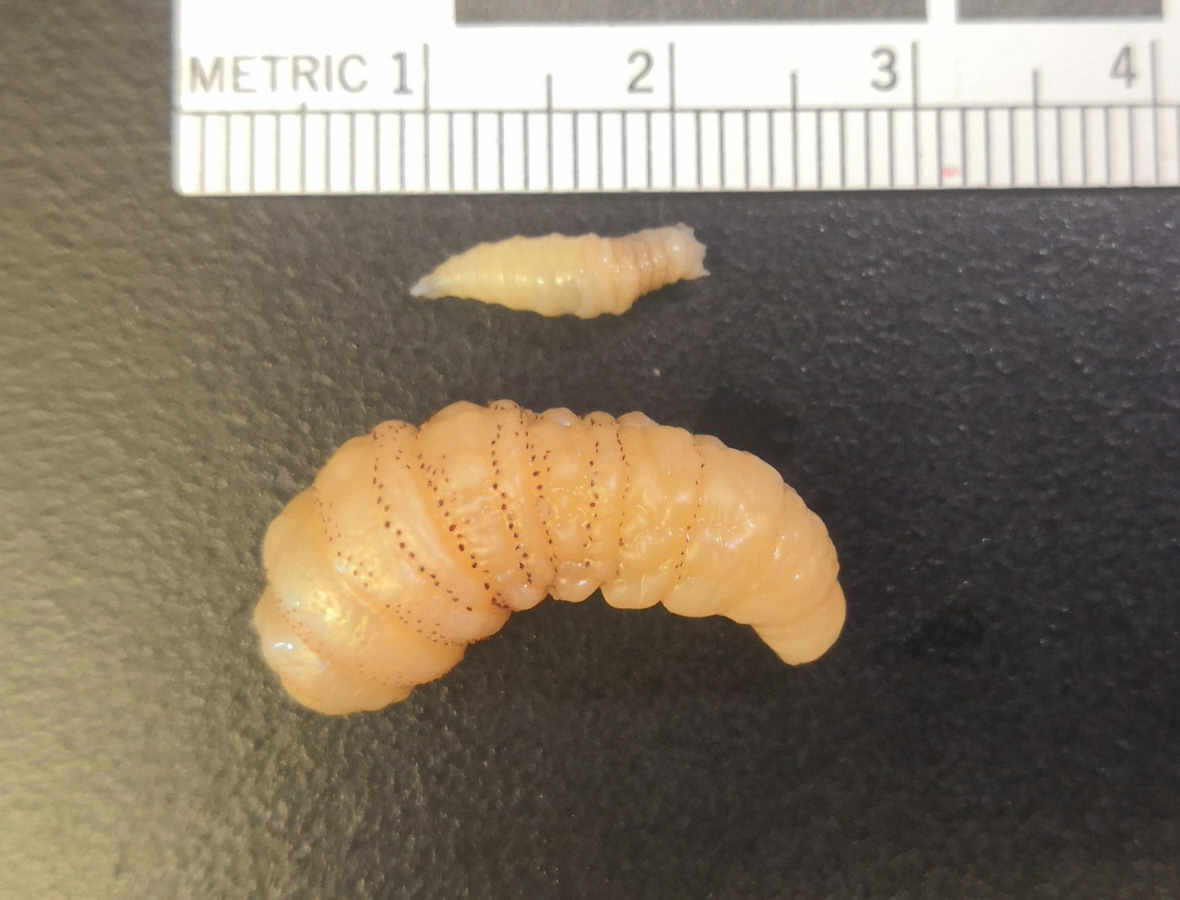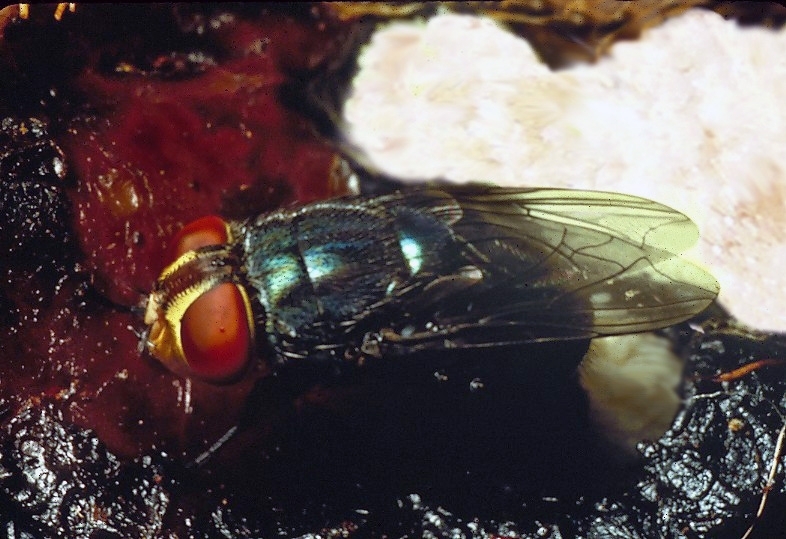
DSHS Health Advisory: Raising Awareness about New World Screwworm

Summary
The Texas Department of State Health Services (DSHS) is raising awareness among public health professionals, human health clinicians, and the public about New World screwworm (NWS), a parasitic fly that can have significant effects on human and animal health. State and federal agencies are preparing for the possible reintroduction of the parasite into the United States. No recent human or animal cases have been identified in Texas, but clinicians should remain vigilant when seeing patients who have traveled in areas where the fly is present and report all suspected NWS cases to their local health department immediately.
Background
New World screwworm myiasis is caused by an infestation with the larvae of Cochliomyia hominivorax, a parasitic fly that feeds on live tissue. NWS infestation begins when the fly lays eggs near wounds or on mucous membranes (nose, ears, mouth) of warm-blooded animals. Within a day, multiple eggs can hatch into larvae and begin to feed. People with NWS infestations may report pain and see or feel movement in the affected area. Larvae will drop to the ground after feeding to complete their lifecycle.
NWS infestation cannot spread from one host to another without the completion of the fly’s life cycle, which ranges from approximately 14-54 days. NWS has the potential to significantly affect local animal populations, so awareness, surveillance, and control of NWS myiasis and C. hominivorax flies in both animals and humans are critical.
NWS was previously eradicated from the United States in the 1960s. Since then, the fly has remained endemic in most of South America, parts of the Caribbean, and southern Panama. In 2023, NWS was detected throughout Central America and was detected in Mexico beginning in November 2024.
There is no immediate risk of infestation to people within the United States; however, travel-related cases have occurred in the past and will continue to be a risk.
Recommendations for Healthcare Providers
Once larvae hatch and begin to feed on live flesh, they typically cause a significant amount of pain within the infested wound. Skin wounds and sores will enlarge and deepen over time and be foul-smelling. One to several hundred larvae can often be seen within a few days of hatching and can grow up to 17mm (approx. 2/3 inch) long.

compared with the larger bot fly larva (bottom) Photo courtesy Mark Fox, CDC | 
Photo courtesy USDA |
Assessment
Healthcare providers should consider NWS if their patient:
- Has recently traveled in areas with animal or human cases of NWS.
- Has a very painful and foul-smelling wound with visible larvae.
- Has a particularly deep wound with extensive tissue damage and evidence of larval infestation.
Has an egg mass in or around a wound or opening
Treatment
There is currently no medication approved for treatment of NWS infestation in humans.
- NWS myiasis in humans is treated by removing ALL larvae. In some cases, surgical removal may be necessary since larvae can burrow deep into wounds to feed. Healthcare providers should be aware of the potential for secondary bacterial infections with NWS myiasis and patients should be assessed clinically for signs of bacterial infection.
- Larvae and eggs should be killed by placing them into a leak-proof container with 70% ethanol. The volume of liquid in the container should be enough to fully submerge the larvae.
- Do not dispose of extracted larvae or eggs in the trash or on the ground without first killing the larvae.
- Re-examine treated lesions after 24 to 48 hours to confirm no live larvae remain.
Diagnosis and Notification of Public Health
Diagnosis is made through identifying morphological features of the larvae.
- Larvae should be removed and immediately placed into a leak proof container with 70% ethanol.
- Larvae submitted for identification should be collected from different depths within the wound.
- Do not dispose of any larvae in the trash or outside in the ground.
- Submerge the remaining larvae and eggs in alcohol in a leak-proof container and place the container into a zip-top plastic bag and seal it.
- Dispose the sealed bag according to your facility’s medical waste disposal protocol.
Failure to kill and properly dispose of all larvae or eggs may result in the new introduction and spread of NWS in the local environment.
Healthcare providers and laboratories should immediately report suspected NWS cases to their local health department. The local health department can advise on sample shipment to the DSHS laboratory in Austin for identification and confirmation by Centers for Disease Control and Prevention (CDC). Public health consultation is available to providers with questions regarding clinical management. These questions can be routed through your local public health department to coordinate with DSHS.
Risk factors
Individuals who travel to areas known to have NWS cases in humans and animals (e.g., Mexico, Central America, South American, and some countries in the Caribbean) may be at increased risk, particularly if they:
- Live, work, or spend an extended amount of time with or near livestock or other warm-blooded animals in areas with reported NWS presence.
- Sleep outdoors or with open, unscreened windows and/or doors in these areas, especially during the day.
- Spend a lot of time outdoors working.
- Have any of the following health conditions that increase the risk of chronic open wounds:
- A weakened immune system.
- Medical conditions that can cause bleeding or open sores, such as from skin cancer.
- Diabetes.
- Poor oral hygiene or gingival disease.
- Have pre-existing open wounds regardless of size, including scratches, cuts, or insect bites.
Prevention Strategies
Those at greater risk for NWS infestation in areas where the fly is present can take the following precautions:
- Wear long, loose-fitting shirts and pants, and socks to limit areas where you could get insect bites.
- Use an EPA-registered insect repellent.
- Treat clothing and gear with products containing 0.5% permethrin.
- Keep open wounds clean and covered.https://www.dshs.texas.gov/regional-local-health-operations/public-health-regions/texas-local-public-health
- Sleep indoors and in rooms with screens.
People who see or feel larvae in or on their wounds should immediately contact their healthcare provider. Larvae should only be removed by a healthcare provider to prevent further tissue damage and ensure all larvae are removed.
For questions about reporting NWS and other reportable conditions, contact your local health department.
Contact the DSHS Zoonosis Control Branch at newworldscrewworm@dshs.texas.gov for questions related to NWS.
Resources
- DSHS Regional Zoonosis Control offices
- New World Screwworm (NWS) | Texas DSHS
- Center for Disease Control and Prevention’s NWS webpage
- Texas Animal Health Commission’s information on reporting and responding to NWS in animals in Texas
- Texas Parks and Wildlife’s information on NWS in Texas wild animals
- Clinical Overview of New World Screwworm | New World Screwworm | CDC
- United Nations Office for Disaster Risk Reduction - New World Screwworm